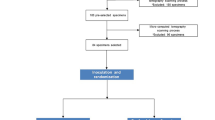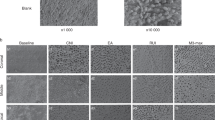Abstract
Objectives
The study aimed to evaluate the potential for the dissolution of organic tissue in areas of simulated complexity and cleaning of root canal walls of the new iVac® endodontic irrigation system.
Material and methods
Thirty mandibular premolars were evaluated by scanning electron microscopy before and after biomechanical preparation. Then, they were distributed according to the final irrigation protocol into groups with conventional irrigation, ultrasonic agitation with metallic insert (UA), and iVac® system, and new photomicrographs were obtained. For tissue dissolution analysis, glass capillaries filled with catgut were attached to the cervical and apical thirds of twenty-one prototyped upper incisors. They were weighed before and after the previously mentioned irrigation protocols. The data were statistically compared with a significance level of 5%.
Results
The final irrigation provided greater cleaning of the root canal walls in the cervical, middle, and apical thirds of the root canals (P < 0.05), with no statistically significant difference between UA and iVac®, regardless of the analyzed thirds. Both ultrasonic irrigation protocols dissolved a significantly greater volume than the conventional irrigation protocol (P < 0.05), with no difference between the two protocols (P < 0.05).
Conclusions
The iVac® system showed root canal wall cleaning and tissue dissolution similar to UA with a metallic insert, and both were superior to conventional irrigation.
Clinical relevance
The new irrigation system iVac is more effective than conventional irrigation and has similar root canal wall cleaning and tissue dissolution to UA.


Similar content being viewed by others
References
Schilder H (1974) Cleaning and shaping the root canal. Dent Clin North Am 18:269–296. https://doi.org/10.1016/s0011-8532(22)00677-2
Zehnder M (2006) Root canal irrigants. J Endod 32:389–398. https://doi.org/10.1016/j.joen.2005.09.014
Haapasalo M, Shen Y, Qian W, Gao Y (2010) Irrigation in endodontics. Dent Clin North Am 54:291–312. https://doi.org/10.1016/j.cden.2009.12.001
Mader CL, Baumgartner JC, Peters DD (1984) Scanning electron microscopic investigation of the smeared layer on root canal walls. J Endod 10:477–483. https://doi.org/10.1016/s0099-2399(84)80204-6
Cleghorn BM, Christie WH, Dong CCS (2006) Root and root canal morphology of the human permanent maxillary first molar: a literature review. J Endod 32:813–821. https://doi.org/10.1016/j.joen.2006.04.014
Kulid JC, Peters DD (1990) Incidence and configuration of canal systems in the mesiobuccal root of Maxillary first and second molars. J Endod 16:311–317. https://doi.org/10.1016/s0099-2399(06)81940-0
Espir CG, Nascimento-Mendes CA, Guerreiro-Tanomaru JM et al (2018) Shaping ability of rotary or reciprocating systems for oval root canal preparation: a micro-computed tomography study. Clin Oral Investig 22:3189–3194. https://doi.org/10.1007/s00784-018-2411-4
Milanezi de Almeida M, Bernardineli N, Ordinola-Zapata R et al (2013) Micro–computed tomography analysis of the root canal anatomy and prevalence of oval canals in mandibular incisors. J Endod 39:1529–1533. https://doi.org/10.1016/j.joen.2013.08.033
Campello AF, Marceliano-Alves MF, Siqueira JF Jr et al (2021) Unprepared surface areas, accumulated hard tissue debris, and dentinal crack formation after preparation using reciprocating or rotary instruments: a study in human cadavers. Clin Oral Investig 25:6239–6248. https://doi.org/10.1007/s00784-021-03922-8
Peters O, Laib A, Gohring T, Barbakow F (2001) Changes in root canal geometry after preparation assessed by high-resolution computed tomography. J Endod 27:1–6. https://doi.org/10.1097/00004770-200101000-00001
Andreani Y, Gad BT, Cocks TC et al (2021) Comparison of irrigant activation devices and conventional needle irrigation on smear layer and debris removal in curved canals. (Smear layer removal from irrigant activation using SEM). Aust Endod J 47:143–149. https://doi.org/10.1111/aej.12482
Caron G, Nham K, Bronnec F, Machtou P (2010) Effectiveness of different final irrigant activation protocols on smear layer removal in curved canals. J Endod 36:1361–1366. https://doi.org/10.1016/j.joen.2010.03.037
Kuah H-G, Lui J-N, Tseng PSK, Chen N-N (2009) The effect of EDTA with and without ultrasonics on removal of the smear layer. J Endod 35:393–396. https://doi.org/10.1016/j.joen.2008.12.007
Liang A, Huang L, Li B et al (2022) Micro-CT evaluation of different root canal irrigation protocols on the removal of accumulated hard tissue debris: a systematic review and meta-analysis. J Clin Med 11:6053. https://doi.org/10.3390/jcm11206053
Verma A, Yadav R, Tikku A et al (2020) A randomized controlled trial of endodontic treatment using ultrasonic irrigation and laser activated irrigation to evaluate healing in chronic apical periodontitis. J Clin Exp Dent e821–e829. https://doi.org/10.4317/jced.56368
van der Sluis LWM, Versluis M, Wu MK, Wesselink PR (2007) Passive ultrasonic irrigation of the root canal: a review of the literature. Int Endod J 40:415–426. https://doi.org/10.1111/j.1365-2591.2007.01243.x
Mancini M, Cerroni L, Iorio L et al (2013) Smear layer removal and canal cleanliness using different irrigation systems (EndoActivator, EndoVac, and Passive Ultrasonic Irrigation): field emission scanning electron microscopic evaluation in an in vitro study. J Endod 39:1456–1460. https://doi.org/10.1016/j.joen.2013.07.028
Al-Jadaa A, Paqué F, Attin T, Zehnder M (2009) Necrotic pulp tissue dissolution by passive ultrasonic irrigation in simulated accessory canals: impact of canal location and angulation. Int Endod J 42:59–65. https://doi.org/10.1111/j.1365-2591.2008.01497.x
Orlowski NB, Schimdt TF, Teixeira CS et al (2020) Smear layer removal using passive ultrasonic irrigation and different concentrations of sodium hypochlorite. J Endod 46:1738–1744. https://doi.org/10.1016/j.joen.2020.07.020
Boutsioukis C, Arias-Moliz MT (2022) Present status and future directions – irrigants and irrigation methods. Int Endod J 55:588–612. https://doi.org/10.1111/iej.13739
Yamada RS, Armas A, Goldman M, Lin PS (1983) A scanning electron microscopic comparison of a high volume final flush with several irrigating solutions: Part 3. J Endod 9:137–142. https://doi.org/10.1016/s0099-2399(83)80032-6
Plotino G, Colangeli M, Özyürek T et al (2020) Evaluation of smear layer and debris removal by stepwise intraoperative activation (SIA) of sodium hypochlorite. Clin Oral Investig 25:237–245. https://doi.org/10.1007/s00784-020-03358-6
Haupt F, Meinel M, Gunawardana A, Hülsmann M (2019) Effectiveness of different activated irrigation techniques on debris and smear layer removal from curved root canals: a SEM evaluation. Aust Endod J 46:40–46. https://doi.org/10.1111/aej.12342
Plotino G, Pameijer C, Mariagrande N, Somma F (2007) Ultrasonics in endodontics: a review of the literature. J Endod 33:81–95. https://doi.org/10.1016/j.joen.2006.10.008
Ahmad M, Pitt Ford TR, Crum LA (1987) Ultrasonic debridement of root canals: an insight into the mechanisms involved. J Endod 13:93–101. https://doi.org/10.1016/s0099-2399(87)80173-5
Macedo R, Verhaagen B, Rivas DF et al (2014) Cavitation measurement during sonic and ultrasonic activated irrigation. J Endod 40:580–583. https://doi.org/10.1016/j.joen.2013.09.018
Petridis X, Busanello FH, So MVR et al (2019) Chemical efficacy of several NaOCl concentrations on biofilms of different architecture: new insights on NaOCl working mechanisms. Int Endod J 52:1773–1788. https://doi.org/10.1111/iej.13198
Sirtes G, Waltimo T, Schaetzle M, Zehnder M (2005) The effects of temperature on sodium hypochlorite short-term stability, pulp dissolution capacity, and antimicrobial efficacy. J Endod 31:669–671. https://doi.org/10.1097/01.don.0000153846.62144.d2
Ng WNI, Marruganti C, Grandini S, Neelakantan P (2021) Root canal debridement by negative pressure irrigation, ultrasonically activated irrigation and their combination. J Oral Sci 63:286–288. https://doi.org/10.2334/josnusd.21-0095
Romualdo PC, de Oliveira KMH, Nemezio MA et al (2017) Does apical negative pressure prevent the apical extrusion of debris and irrigant compared with conventional irrigation? A systematic review and meta-analysis. Aust Endod J 43:129–137. https://doi.org/10.1111/aej.12162
Jiang L-M, Verhaagen B, Versluis M et al (2011) The influence of the ultrasonic intensity on the cleaning efficacy of passive ultrasonic irrigation. J Endod 37:688–692. https://doi.org/10.1016/j.joen.2011.02.004
Retsas A, Koursoumis A, Tzimpoulas N, Boutsioukis C (2016) Uncontrolled removal of dentin during in vitro ultrasonic irrigant activation in curved root canals. J Endod 42:1545–1549. https://doi.org/10.1016/j.joen.2016.07.006
Rodrigues CT, EzEldeen M, Jacobs R et al (2021) Cleaning efficacy and uncontrolled removal of dentin of two methods of irrigant activation in curved canals connected by an isthmus. Aust Endod J 47:631–638. https://doi.org/10.1111/aej.12534
Mancini M, Cerroni L, Iorio L et al (2017) FESEM evaluation of smear layer removal using different irrigant activation methods (EndoActivator, EndoVac, PUI and LAI). An in vitro study. Clin Oral Investig 22:993–999. https://doi.org/10.1007/s00784-017-2179-y
Virdee SS, Seymour DW, Farnell D et al (2017) Efficacy of irrigant activation techniques in removing intracanal smear layer and debris from mature permanent teeth: a systematic review and meta-analysis. Int Endod J 51:605–621. https://doi.org/10.1111/iej.12877
Funding
This study was funded by the State of São Paulo Research Foundation, FAPESP (process number: 2021/10378–7).
Author information
Authors and Affiliations
Contributions
Marco Antonio Hungaro Duarte, Murilo Priori Alcalde, and Rodrigo Ricci Vivan contributed to the conceptualization. Raimundo Sales de Oliveira Neto, Luana Arantes de Souza Lima, and Marco Antonio Hungaro Duarte contributed to the methodology. Pedro Cesar Gomes Titato and Luana Arantes de Souza Lima contributed to the investigation. Murilo Priori Alcalde, Rodrigo Ricci Vivan, and Marco Antonio Hungaro Duarte contributed to the formal analysis. Pedro Cesar Gomes Titato and Raimundo Sales de Oliveira Neto contributed to data curation. Raimundo Sales de Oliveira Neto, Pedro Cesar Gomes Titato, and Luana Arantes de Souza Lima wrote and prepared the original draft. Rodrigo Ricci Vivan, Marco Antonio Hungaro Duarte, and Flaviana Bombarda de Andrade contributed to the review and editing of the study report. Marco Antonio Hungaro Duarte contributed to supervision. Murilo Priori Alcalde and Marco Antonio Hungaro Duarte contributed to project administration. Marco Antonio Hungaro Duarte contributed to funding acquisition.
Corresponding author
Ethics declarations
Ethical approval
This study was submitted to the Human Research Ethics Committee of the Bauru School of Dentistry – University of São Paulo (CAAE 62875122.6.0000.5417) and was in accordance with the ethical standards of the institutional and national research committee for human research.
Informed consent
Not applicable.
Competing interests
The authors declare no competing interests.
Additional information
Publisher's Note
Springer Nature remains neutral with regard to jurisdictional claims in published maps and institutional affiliations.
Rights and permissions
Springer Nature or its licensor (e.g. a society or other partner) holds exclusive rights to this article under a publishing agreement with the author(s) or other rightsholder(s); author self-archiving of the accepted manuscript version of this article is solely governed by the terms of such publishing agreement and applicable law.
About this article
Cite this article
de Oliveira Neto, R.S., de Souza Lima, L.A., Titato, P.C.G. et al. Effectiveness of a new endodontic irrigation system for removing smear layer and dissolving simulated organic matter. Clin Oral Invest 28, 10 (2024). https://doi.org/10.1007/s00784-023-05418-z
Received:
Accepted:
Published:
DOI: https://doi.org/10.1007/s00784-023-05418-z




